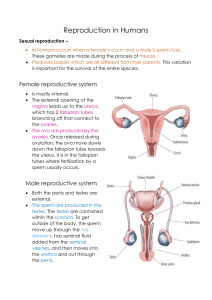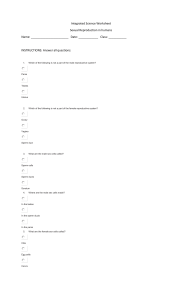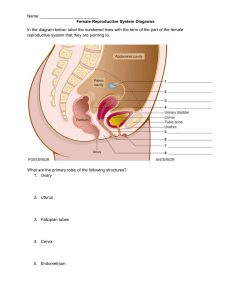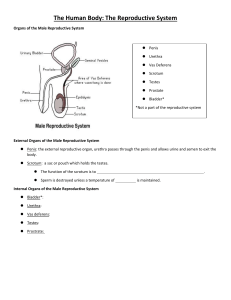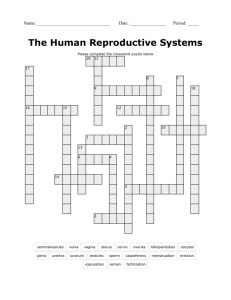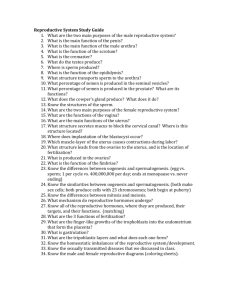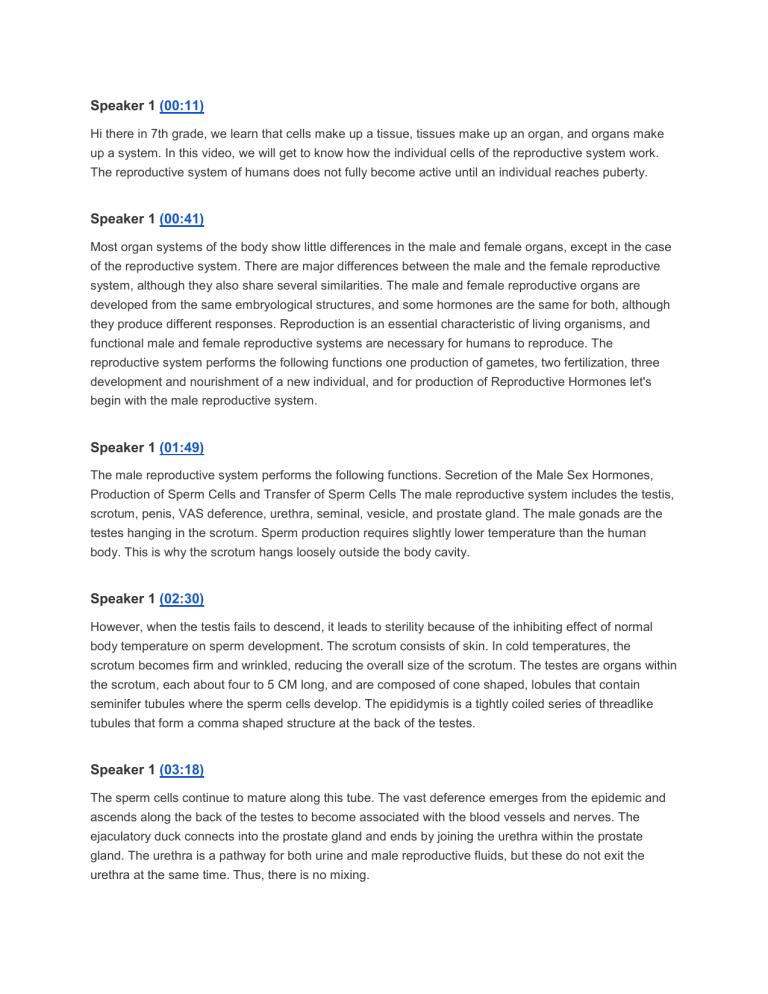
Speaker 1 (00:11) Hi there in 7th grade, we learn that cells make up a tissue, tissues make up an organ, and organs make up a system. In this video, we will get to know how the individual cells of the reproductive system work. The reproductive system of humans does not fully become active until an individual reaches puberty. Speaker 1 (00:41) Most organ systems of the body show little differences in the male and female organs, except in the case of the reproductive system. There are major differences between the male and the female reproductive system, although they also share several similarities. The male and female reproductive organs are developed from the same embryological structures, and some hormones are the same for both, although they produce different responses. Reproduction is an essential characteristic of living organisms, and functional male and female reproductive systems are necessary for humans to reproduce. The reproductive system performs the following functions one production of gametes, two fertilization, three development and nourishment of a new individual, and for production of Reproductive Hormones let's begin with the male reproductive system. Speaker 1 (01:49) The male reproductive system performs the following functions. Secretion of the Male Sex Hormones, Production of Sperm Cells and Transfer of Sperm Cells The male reproductive system includes the testis, scrotum, penis, VAS deference, urethra, seminal, vesicle, and prostate gland. The male gonads are the testes hanging in the scrotum. Sperm production requires slightly lower temperature than the human body. This is why the scrotum hangs loosely outside the body cavity. Speaker 1 (02:30) However, when the testis fails to descend, it leads to sterility because of the inhibiting effect of normal body temperature on sperm development. The scrotum consists of skin. In cold temperatures, the scrotum becomes firm and wrinkled, reducing the overall size of the scrotum. The testes are organs within the scrotum, each about four to 5 CM long, and are composed of cone shaped, lobules that contain seminifer tubules where the sperm cells develop. The epididymis is a tightly coiled series of threadlike tubules that form a comma shaped structure at the back of the testes. Speaker 1 (03:18) The sperm cells continue to mature along this tube. The vast deference emerges from the epidemic and ascends along the back of the testes to become associated with the blood vessels and nerves. The ejaculatory duck connects into the prostate gland and ends by joining the urethra within the prostate gland. The urethra is a pathway for both urine and male reproductive fluids, but these do not exit the urethra at the same time. Thus, there is no mixing. Speaker 1 (03:55) The male urethra connects from the urinary bladder to the distal end of the penis, while seminal fluid passes through the urethra. A reflex causes the urinary sphincter muscles to contract tightly to keep urine from passing the urinary bladder through the urethra. The penis is only an accessory organ for reproduction and not the reproductive organ itself, as most people think, it is the organ for population, and it functions in a transfer of sperm cells from the male to the vagina of the female. The penis is composed of erectile tissues. The engorgement of the erectile tissue with blood causes the penis to enlarge and become firm in a process called erection. Speaker 1 (04:46) Testosterone is the main male sex hormone secreted by the testes. This hormone is responsible for the normal development of the organs of the male reproductive system. It also brings about the. Speaker 1 (05:00) A change's experience during puberty. The changes that appear at ten to 14 years of age eventually distinguish the male secondary characteristics. Secondary male characteristics include growth of facial underarm, chest pubic and body hair, enlargement of the voice box resulting to deepening of the voice, development of the male musculature and genitals, and increased secretion of sweat and oil resulting to acne. Speaker 1 (05:35) Moreover, testosterone is responsible for male's muscular strength. This is why some athletes take steroids that contain testosterone or other similar compounds. However, taking steroids have been proven to produce harmful effects and may even result to mental problems. All right, that's all for the male reproductive system. Let's proceed to the female reproductive system. Speaker 1 (06:04) The female reproductive system has the following functions. Production of female sex cells, production of female sex hormones, reception of sperm cells from the male and nurturing the development of and providing nourishment for the new individual. The female reproductive system performs female sexual and childbearing functions. It consists of a pair of gonads or the ovaries, fallopian tubes or oviducts, the uterus, the vagina, and the external genitalia or the vulva. There are two ovaries, each comparable to the size of an almond nut in every female. Speaker 1 (06:53) The ovary contains an ovarian follicle, which contains an oocyte or the female germ cell. When follicles mature, they expand and rupture to release the egg. This process is called ovulation. After ovulation, the remaining cells of the ruptured follicle transform into a glandular structure known as the corpus luteum. The fallopian tubes, also called uterine tubes, extend from the area of the ovaries to the uterus. Speaker 1 (07:28) The long and thin processes called fimbriae, surround the opening of each uterine tube. Fertilization usually occurs in the part of the fallopian tube near the ovary. The uterus is as big as a medium sized pair. The part of the uterus above and near the entrance of the fallopian tubes is called the fungus. The main part is called the body, and the narrower part is the cervix. Speaker 1 (07:59) Internally, the uterine cavity continues through the cervix as the cervical canal, which opens into the vagina. The vagina is the female organ for copulation, and it functions to receive the penis during intercourse. It also allows menstrual flow and childbirth. This extends from the uterus to the outside of the body. In young females, the vaginal opening is covered by a thin mucous membrane called hymen. Speaker 1 (08:32) The hymen can completely close to vaginal opening, in which case it must be removed to allow menstrual flow. This can be torn at some earlier time in a young female's life during a variety of activities, which may include strenuous, exercise. The condition of the hymen is therefore not a reliable indicator of virginity. Did you know that a woman's ovaries contain follicles that nurture eggs and produce sex hormones? The pair of ovaries lying on the right and left depression of the upper pelvic cavity produces the mature egg cells. Speaker 1 (09:13) This mature egg cell is swept by the tiny fingerlike projections of the oviducts or fallopian tubes. The egg moves along this tube with the help of the tiny hair or Celia that line the fallopian tubes. These tubes extend until the uterus the uterus an inverted pear-shaped muscular organ is where the embryo attaches specifically on its inner wall. The endometrium A female is considered pregnant when successful implantation happens, the uterus opens into the vagina which receives the penis during intercourse and serves as the birth canal. The cervix an important reproductive part during birthing.
